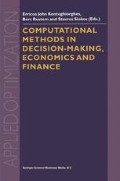Abstract
The main goal of this chapter is to formulate a robust mean-semivariance portfolio selection problem in terms of a linear matrix inequalities (LMI) optimization problem. We consider different forms of calculating the mean and semivariance of the tracking error. It is desired to minimize an objective function defined as a convex combination of the risk function minus the expected return of the tracking error.
Partial funding provided by FAPESP grant 97/04668-1, CNPq grant 305173/88 and PRONEX grant 015/98.
Access this chapter
Tax calculation will be finalised at checkout
Purchases are for personal use only
Preview
Unable to display preview. Download preview PDF.
References
Black, F. and Litterman, R. (1991). Asset allocation: Combining investor views with market equilibrium. Journal of Fixed Income, 1: 7–18.
Boyd, S., Ghaoui, L. E., Feron, E., and Balakrishnan, V. (1994). Linear Matrix Inequalities and Control Theory. SIAM, Philadelphia.
Campbell, J. Y., Lo, A. W., and MacKinlay, A. C. (1997). The Econometrics of Financial Markets. Princenton University Press.
Costa, O. L. V., do Val, J. B. R., and Geromel, J. C. (1997). A convex programming approach to H2-control of markovian jump linear systems. International Journal of Control, 66: 557–579.
Costa, O. L. V. and Paiva, A. C. (2002). Robust portfolio selection using linear matrix inequalities. Journal of Economic Dynamics and Control, 26: 889–909.
Duarte Jr., A. M. (1999). Fast computation of efficient portfolios. The Journal of Risk, 4: 71–94.
Elton, E. J. and Gruber, M. J. (1995). Modern Portfolio Theory and Investment Analysis. Wiley, New York.
Geromel, J. C., Peres, P. L. D., and Bernussou, J. (1991). On a convex parameter space method for linear control design of uncertain systems. SIAM J. on Control and Optimization, 29: 381–402.
Ghaoui, L. E. and Niculescu, S. I. (2000). Advances in Linear Matrix Inequality Methods in Control. SIAM, Philadelphia.
Hanza, F. and Janssen, J. (1995). Portfolio optimization model using asymmetric risk function. Proc.5th AFIR, Brussels, Belgium, Vol III bis, pages 3–32.
Hanza, F. and Janssen, J. (1998). The meansemivariances approach to realistic portfolio optimization subject to transactions costs. Applied Stochastics Models and Data Analysis, 14: 275–283.
Howe, M. A. and Rustem, B. (1997). A robust hedging algorithm. Journal of Economic Dynamics and Control, 21: 1065–1092.
Howe, M. A., Rustem, B., and Selby, M. J. P. (1996). Multi-period minimax hedging strategies. European Journal of Operational Research, 93: 185–204.
Jorion, P. (1992). Portfolio optimization in practice. Financial Analysts Journal (January-February), 1: 68–74.
Markowitz, H. (1959). Portfolio Selection: Efficient Diversification of Investments. John Wiley, New York.
Oliveira, M. C., Faria, D. P., and Geromel, J. C. (1994). Lmisol user’s guide. Available at http: //www. dt. fee. unicamp. br/—carvalho/soft.
Roll, R. (1992). A mean/variance analysis of tracking error. The Journal of Portfolio Management, 18: 13–22.
Rudolf, M., Wolter, H. J., and Zimmermann, H. (1999). A linear model for tracking error minimization. The Journal of Banking and Finance, 23: 85–103.
Rustem, B., Becker, R. G., and Marty, W. (1995). Robust min-max portfolio strategies for rival forecast and risk scenarios. Journal of Economic Dynamics and Control, 24: 1591–1621.
Saberi, A., Sannuti, P., and Chen, B. M. (1995). H2-Optimal Control. Prentice Hall.
Zenios, S. A. (1993). Financial Optimization. Cambridge University Press.
Author information
Authors and Affiliations
Editor information
Editors and Affiliations
Rights and permissions
Copyright information
© 2002 Springer Science+Business Media Dordrecht
About this chapter
Cite this chapter
Costa, O.L.V., de Barros Nabholz, R. (2002). A Linear Matrix Inequalities Approach to Robust Mean-Semivariance Portfolio Optimization. In: Kontoghiorghes, E.J., Rustem, B., Siokos, S. (eds) Computational Methods in Decision-Making, Economics and Finance. Applied Optimization, vol 74. Springer, Boston, MA. https://doi.org/10.1007/978-1-4757-3613-7_6
Download citation
DOI: https://doi.org/10.1007/978-1-4757-3613-7_6
Publisher Name: Springer, Boston, MA
Print ISBN: 978-1-4419-5230-1
Online ISBN: 978-1-4757-3613-7
eBook Packages: Springer Book Archive

